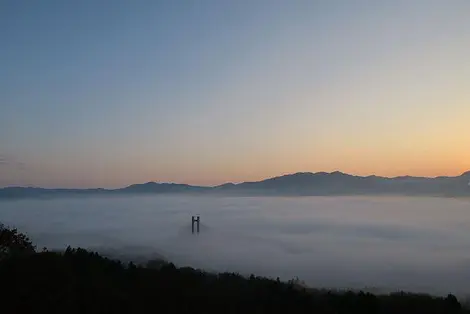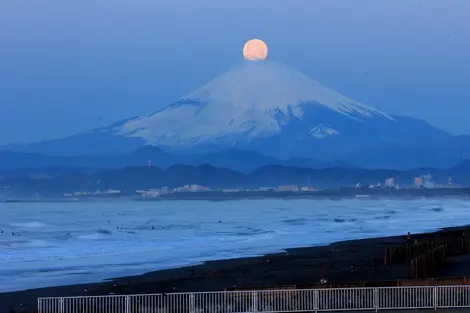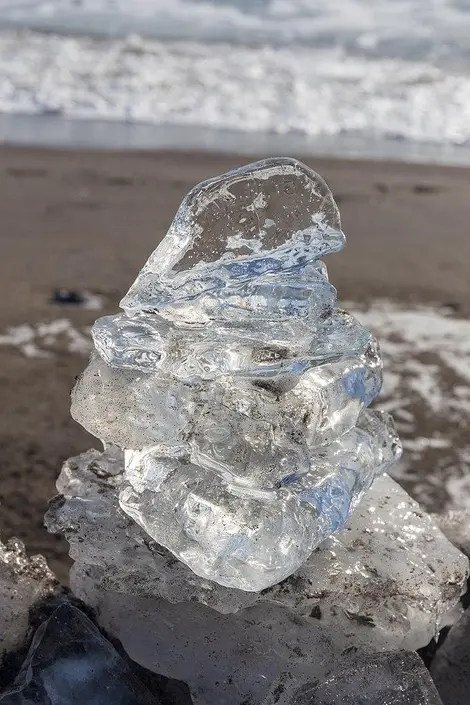The most beautiful natural phenomena of Japan
Must-sees in Japan: Masterpieces of Japanese Nature
Besides the blooming sakura and the blushing leaves during the koyo season; events well known to tourists visiting Japan, however, Japan also has many other natural wonders! Japan Experience invites you to discover several breathtaking natural phenomena! To experience these incredible phenomena, we have selected the best viewing sites for you. All you have to do is admire the wonders of Japanese nature!
Unkai, "sea of clouds"
In some Japanese valleys, it is possible to witness a mysterious atmospheric phenomenon, called unkai, literally "sea of clouds". Requiring special atmospheric and weather conditions, the unkai only occurs randomly in spring and fall. Early in the morning, when the air is dry and warm at altitude, and cool and humid on the ground, the valley surrounded by mountains becomes covered with dense clouds. The Unkai offers its spectators a breathtaking landscape! The mountains seem to float like islands on the surface of this cottony sea.
Where to see a sea of clouds or unkai in Japan?
To appreciate a beautiful sea of clouds, we advise you to find out beforehand for each of the observatories about the times of the unkai and the weather conditions favorable to the occurrence of the phenomenon.
The Minoyama Park Observatory in Chichibu (Saitama Prefecture)
Address: Minano, Chichibu, Saitama 369-1412, Japan
Phone: +81494231511
Hours: open every day.
Access: From Tokyo, take the Limited Express Red Arrow train from Ikebukuro station (90 min) then a 1.5 hour walk from Chichibu Railway Minano station via a hiking trail.
Unkai Terrace in Tomamu (Hokkaido Prefecture)
Address: Nakatomamu, Shimukappu-mura, Yufutsu-gun 079-2204 Hokkaido
Hours: Open from mid-May to mid-October from 4 a.m. to 8 a.m. (May - August) and 4:30 a.m. to 8 a.m. (September to October).
Gondola fare: 1,900 yen ($ 17.93) adult, 1,200 yen ($ 11.32) child
Access: From Chitose airport: take the fast train to Minami-Chitose (3 min) then change to the limited express Super Ozora or Super Tokachi (1h10) to Tomamu. From Sapporo: Take the Super Ozora or Super Tokachi limited express train to Tomamu station (1h40). To reach the unkai terrace, take the cable car.
The ruins of Takeda Castle (Hyogo Prefecture)
Address: 169 Takeda, Wadayama-cho, Asago-city, Hyogo
Telephone: +81 79-672-4003
Hours: Open 8 a.m. to 6 p.m. (March to May), 6 a.m. to 6 p.m. (June to August), 4 a.m. to 5 p.m. (September to November), 10 a.m. to 2 p.m. (December to January)
Price: 500 yen ($ 4.72)
Access: From Himeji, take the JR Bantan Line to Takeda Station. From Takeda Station, the castle is a 40-minute walk or 20-minute bus ride. The Tenku bus runs from March to November between Takeda station and the Takedajo-seki bus stop (20 minutes, 260 yen one way or $2.45). About one bus per hour.
Tsubetsu Toge Out Look (Hokkaido Prefecture)
Address: Kamisato, Tsubetsu-cho, Abashiri-gun 092-0222 Hokkaido
Telephone: +81 152-76-2151
Hours: Open from 1st June to 31st October. Special tour dedicated to the observation of the unkai which leaves at 6:00 am from the Kussharo Prince Hotel
Price: 3,000 yen ($ 28.32) adult, 1,800 yen ($ 16.99) child, 700 yen ($ 6.61) under 3 years old
Access: From JR Kushiro station, take the train to Mashu or Kawayu-onsen station, then the city bus.
SORA terrace in Nagano
It often appears between 9 a.m. and 10:30 a.m. and / or 4 p.m. to 7 p.m.
Address: Yomase, Yamanochi, Shimotakai District, Nagano 381-0405
Telephone: +81 269-33-7131
Hours: Open from May to November from 9 a.m. to 7 p.m.
Price: Round-trip cable car ticket: 2,300 yen ($ 21.71) adult, 1,200 yen ($ 11.32) child
Access: from Yutanaka station, take the shuttle to reach the Ryuoo cable car (20 min)
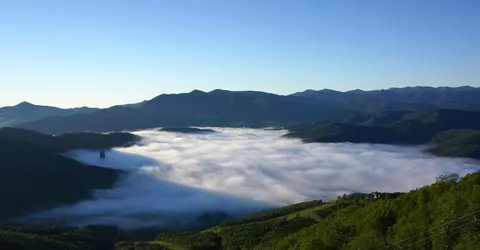
Unkai, the cloud sea
Kentaro Ohno
The Fuji diamond or Diamond Fuji
At certain times of the year, the rising or setting sun aligns perfectly with the summit of Mount Fuji. This natural phenomenon is called Diamond Fuji. The cone of the sacred mountain is illuminated like a sparkling diamond by the rays of the sun. We even speak of Double Diamond Fuji when the phenomenon is reflected in the waters of a lake!
Where to see the Diamond Fuji?
While the Diamond Fuji can be observed from some observatories in the capital, such as the Tokyo Metropolitan Government Headquarters (Tokyo City Hall) and the Tokyo Skytree, it is preferable to reach the following places located just a stone's throw from Tokyo. Indeed, what could be better than enjoying this spectacle in the heart of nature? Check in advance with each observation site because the Diamond Fuji occurs on different dates depending on the location.
The Summit of Mount Takao
Diamond Fuji period: in December, around the winter solstice. Best time: between 4:00 p.m to 4:15 p.m.
Access: Take the JR Chuo line to Takao station or take the Keio line in Shinjuku to Takaosanguchi station with a change at Kitano station.
Yamanaka lake
Diamond Fuji period: mid-October to end of February
Access: By bus (recommended): Keio or Fujikyu lines, 2 hours and 1,750 yen to Kawaguchiko station or by train: JR Chuo line from Shinjuku (limited express train) to Otsuki (70 min, 2,500 yen) then take the Fujikyu line to Kawaguchiko station (55 minutes, 1,140 yen). Then take a bus to the Hirano stop (25 min).
Tanuki Lake
Diamond Fuji period: mid-April to mid-August
Access: From Tokyo, take a JR Kanto or Fujikyu bus connecting Tokyo station (Yaesu South exit) to Fujinomiya station in 2h30 for 2,570 yen ($ 24.25) then take a bus from Fujinomiya station to lake (about 30 min).
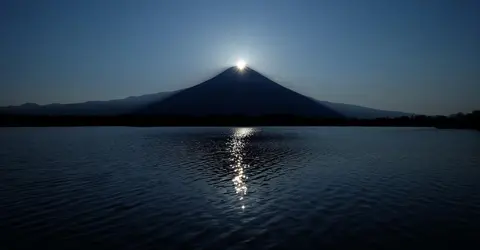
Diamond Fuji
Flickr Jamin96
The Pearl of Mount Fuji or Pearl Fuji
The Pearl Fuji is the counterpart of the Diamond Fuji but this time with the moon star! On full moon days, the star seems to land delicately on Mount Fuji's summit like a precious pearl sheltered in its comfortable setting. The moon lights the sacred mountain with its gentle radiance, a magnificent scene that is nicknamed "the pearl of Mount Fuji". But to observe the pearl of Mount Fuji, luck will have to be on your side; the dates are not fixed from one year to the next ...
Where to see the Pearl Fuji?
Kugenuma Beach in Fujisawa
Address: Kugenuma Beach, Fujisawa, Kanagawa Prefecture 251-0037, Japan
Access: From Shinjuku Station, take the JR Shonan Shinjuku line, then transfer at Fujisawa to Enoshima via the Enoshima Electric Railway (1,190 yen). Continue on foot towards the beach (5 min).
The ice gems of Hokkaido
Every year in Hokkaido, in the coldest winter, a beach is adorned with ice gems. This phenomenon, known as jewelry or ice gems occurs on the coastline of Toyokoro town. During January and February, the frozen water of the Tokachi River breaks up at the mouth of the river and the Pacific Ocean. This ice then runs aground on Otsu beach where it is polished by the sand. The blocks of ice then take on the appearance of precious stones. Similar to diamonds in the early morning, the chunks of ice take on an amber hue at sunset.
Where to see the ice gems?
Otsu beach
Address: Otsu-motomachi, Toyokoro-cho, Nakagawa-gun, Hokkaido
Access: From Sapporo station, take the JR Super Ozora express train to Obihiro (about 3 hours), then take a bus or taxi for 1 hour to reach the coast of Toyokoro town.




